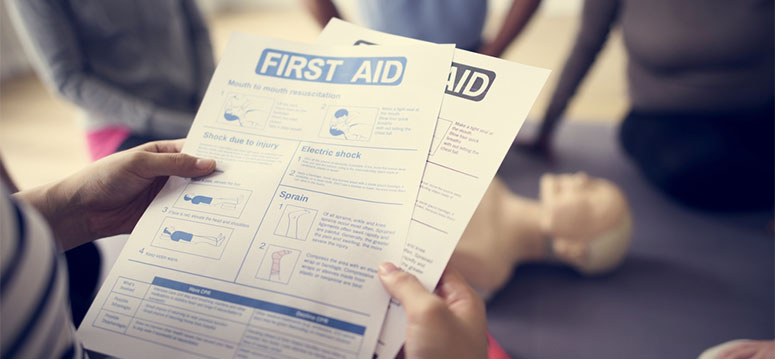WCB – Everything you wanted to know about WCB Premiums but were afraid to ask

Such is the quote on the Insurance and Premiums page of the WCB Alberta’s website. While the statement is true, it is incomplete; workers’ compensation is also just like any other insurance – you have to pay premiums to get coverage and keeping premiums low makes good business sense.
Although paying WCB premiums is not optional for many employers, knowing how premiums are established can help manage premium rates. WCB premium rates are calculated using a multifactorial formula of fixed and variable components. While employers have no control over the fixed aspects, they do have a degree of influence over the variable factors.
Employer Premium Rate Statement (EPRS)
In Alberta, the WCB issues an Employer Premium Rate Statement (EPRS) annually to every employer that pays WCB premiums and all the information used to establish premium rates is contained on this statement. The key to managing your premium rate begins with understanding this statement; knowing where the data comes from, how the calculations work and what parts you, as an employer, have control of and which you do not.
The WCB premium rate, for any employer, is the cost of coverage per $100 of insurable earnings for all workers of their company. The rate is specific to each employer but based in a broader calculation using statistical information from other employers with similar business operations and business risks. The following is a general explanation and breakdown of the EPRS.
All employers categorized into Industry Classifications depending on the business they conduct. Industry Classifications are then consolidated into different Rate Groups determined by employers with similar business activities and claims experience. Each Rate Group has a rate established from statistical information, collected from the industries in that Rate Group, which is used as the foundation for calculating an employer’s premium rate. This is known as the Industry Rate.

An employer’s own claims experience is then used to calculate their Rate Adjustment. This is the area where employers can have the most impact. If an employer has better than average claims experience compared to employers of similar size (based on insurable their earnings), they will receive a discount; if an employer’s claims experience record is higher than the Industry Average, they are levied a surcharge.
The Rate Adjustment, discount or surcharge, when applied to the Industry Rate determines the Employer’s Premium Rate.
The Rate Adjustment is determined by calculating an employer’s Experience Rating Plan discount or surcharge and then, if applicable, adding a Poor Performance Surcharge (PPS).
Experience Rating Plans (ERP)
There are two Experience Rating Plans (ERP) one for small employers and one for large employers. Participation in each plan is determined by how much industry-rated premiums an employer pays over a 3 year period. Small employers are defined as paying less than $15,000 in a 3 year period, large employers pay $15,000 or more.
The ERP for small employers depends on the number of time loss claims an employer has experienced in a 5 year period. If they have no time loss claims, they are awarded a 5% discount. If they have between 1 and 4 time loss claims in that 5 year period, their premium is based on the Industry Rate. If they have 5 or more claims in the 5 year period, they will be levied a 5% surcharge. Clearly the better an employer’s claims record, the less they will pay in premiums.
The ERP for large employers is a little more complicated. The ERP is calculated by determining an employer’s Experience Ratio, multiplying it by their Participation Factor and their Eligibility Factor.
- The Employer Experience Ratio is the percentage an Employer’s Claim Costs are above or below the Industry Average Claim Costs. The ratio is limited to a maximum percentage based on the pricing program an employer is involved in.
- Employer Claim Costs – are the total claim costs from the Experience Rating Claims Costs page of the EPRS, over the specific 3 year period, which are used to determine the Employer Experience Ratio. Therefore controlling claim costs will help to lower the costs being used to determine an employer’s comparison to the industry average.
- Industry Average Claim Costs – are the average costs associated with the WCB claims for all employers within the same Industry Classification/Rate Group over the same 3 year period.
- The Participation Factor refers to the size of an employer and is reflective of their contribution to the industry premiums. The participation factor limits the maximum percentage of discount or surcharge that can be applied and protects employers from excessive changes in premiums rates, as well as ensuring that rate adjustments are based on credible statistical information. As a rule, for every $4,000 of industry rated premiums an employer, under the standard program, pays over a 3 year period, they are awarded 1% participation up to a maximum of 50% under the Standard Program. For an employer participating in the ICP program, the amount used for the calculation of the ERP can be as low as 1% for every $1,000 of industry rated premiums.
- The Eligibility Factor refers to the number of years an employer’s account has been open during the 3 year experience period used to collect claims costs information. It recognizes that if an employer has only been operating for one year out of the 3 year experience period, the factor used would be ⅓; if they were operating for two out of the 3 years, the factor would be ⅔ and if they were operational for all 3 years, a factor of 1 would be used in the calculation of Experience Rating Plan, to determine full participation.
Poor Performance Surcharge (PPS) only affects large employers and is added to the EPRS/Assessment only if their Experience Rating Costs are consistently more than 80% higher than the industry average over a five year period. The PPS is capped to a maximum of 200% is layered on top of their ERP surcharge. It is used as incentive for employers to take immediate action to improve health and safety management efforts and reduce work-related injuries.
WCB Incentive Pricing Programs
Although not clearly defined on the EPRS, there are additional WCB incentive pricing programs that can affect the amount WCB premiums an employer pays:
 Partners for Injury Reduction (PIR) is voluntary program for all employers that can result in an industry rated WCB premium rebate. By joining PIR and maintaining a Certificate of Recognition (COR), an employer can realize up to a 20% industry rated rebate determined by their participation in the program; i.e. improving claims experience year over year and/or maintaining at least 50% better than Industry Average Claims Costs for two consecutive years or more. In fact, employers will automatically receive a 10% industry rated rebate for initially achieving their COR.
Partners for Injury Reduction (PIR) is voluntary program for all employers that can result in an industry rated WCB premium rebate. By joining PIR and maintaining a Certificate of Recognition (COR), an employer can realize up to a 20% industry rated rebate determined by their participation in the program; i.e. improving claims experience year over year and/or maintaining at least 50% better than Industry Average Claims Costs for two consecutive years or more. In fact, employers will automatically receive a 10% industry rated rebate for initially achieving their COR.
Industry Custom Pricing (ICP) is program introduced by the WCB to allow industries to customize various features of their experience rating to match their risk preference. The intent of ICP is to provide flexibility, encourage accountability and more accurately reflect individual claims performance while still focusing on injury prevention. Although there are certain advantages to ICP, it is not always the best option and close examination of the risks versus benefits should be undertaken before opting to join ICP. It should also be noted that participation in ICP is decided by the industry as a whole; if the majority of the employers (or the majority of employers’ insurable earnings) within an industry vote to join ICP, participation is mandatory for every employer in that industry, regardless of how an individual employer voted.
Where do Employers have an impact?
There are 4 main areas that employers can have an influence over their WCB Premium Rate:
ICP can, but does not always, result in industry rated discounts; surcharges associated with ICP can be higher than the standard pricing model. Therefore involvement in ICP should be given careful consideration.

Although EPRS and WCB Premium Rate setting can be complicated and complex, it still remains that accident prevention is the single most effective tool an employer can use to lower WCB premiums and if accident prevention fails, cost containment of the resultant claims is essential to keeping claims cost down.
For further information or explanation of WCB Premiums, WCB pricing programs and/or WCB claims management, you can connect with us on Facebook , Twitter , or LinkedIn. You can reach us via email at [email protected], [email protected] or contact us directly, during business hours, using our chat feature or call us at 1-844-377-9545.




